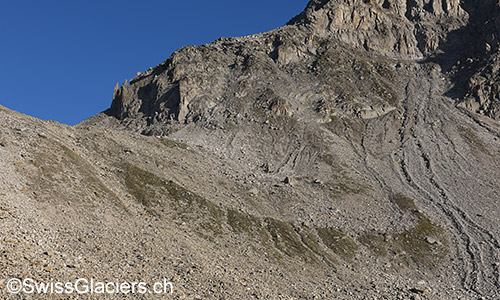|<<>>|Overview
End or terminal moraine
A growing glacier pushes debris and boulders in front of it. If it is stationary, rocks fall and/or slide from the end of the glacier onto the forefield. In both cases, a wall of debris and boulders of different sizes is formed. This wall is called terminal moraine.
When the glacier retreats, the terminal moraine remains behind and marks the maximum of the advance. Several terminal moraines can form in front of a glacier. Existing terminal moraines can be rolled over and destroyed by a larger glacier advance.
View from above of a terminal moraine of Tälli glacier (Binntal).
The glacier has retreated to the left.
Photo from 30.7.2018.
View from above towards a terminal moraine of Witenwasseren glacier.
The terminal moraine is visible at lower right, the glacier at the upper margin.
We found no evidence that the boulders were arranged by human hand.
Photo from 26.8.2019
 Photo from 4.9.2020.' alt='Terminal moraine of the Chüeboden glacier on the southern side of the Gerenpass.'/>
Photo from 4.9.2020.' alt='Terminal moraine of the Chüeboden glacier on the southern side of the Gerenpass.'/>
Terminal moraine of the Chüeboden glacier on the southern side of the Gerenpass.
Around 1880, the tongue of the Chüeboden glacier reached as far as this terminal moraine,
which can be verified with
Show for the term «End or terminal moraine»:Photos
Published / Updated:
09.02.2019 /
27.09.2020
|<<>>|Overview